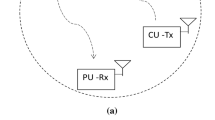Abstract
The cognitive radio technology enables secondary users (SUs) to occupy licensed bands when primary users (PUs) are not occupy them. Spectrum sensing is a key technology for SUs to detect PUs, and the sensing time is a critical parameter for spectrum sensing performance. Optimum sensing time tradeoffs between the spectrum sensing performance and the secondary throughput. This paper proposes a novel spectrum sensing scheme that performs spectrum sensing for either one period or two periods based on the previous sensing result. Due to the energy constraint in cognitive radio sensor networks, the energy efficiency is maximized by optimizing spectrum sensing time. In order to seek the optimal sensing time, the objective function is proven to be a concave function and the Golden Section Search method is employed. Our simulation study verifies that the proposed scheme improves the network energy efficiency, especially when PUs are more active.









Similar content being viewed by others
References
Federal Communications Commission. (2003). FCC, ET Docket No 03-222 Notice of proposed rule making and order. Technical Report.
Mitola, J., & Maguire, G. Q. (1999). Cognitive radio: Making software radios more personal. IEEE Personal Communications, 6(4), 13–18.
Saifan, R., Kamal, A. E., & Guan, Y. (2012). Spectrum decision for efficient routing in cognitive radio network. In Mobile Adhoc and Sensor Systems (pp. 371–379).
Almasaeid, H. M., Jawadwala, T. H., & Kamal, A. E. (2010). On-demand multicast routing in cognitive radio mesh networks. In Global Telecommunications Conference.
Askari, M., Kavian, Y. S., Kaabi, H., & Rashvand, H. F. (2012). A channel assignment algorithm for cognitive radio wireless sensor networks. In Wireless Sensor Systems (WSS) (pp. 1–4).
Puccinelli, D., & Haenggi, M. (2005). Wireless sensor networks: Applications and challenges of ubiquitous sensing. IEEE Circuits and Systems Magazine, 5(3), 19–31.
Ewaisha, A., Sultan, A., & ElBatt, T. (2011). Optimization of channel sensing time and order for cognitive radios. In Wireless Communications and Networking Conference (WCNC) (pp. 1414–1419).
He, H., Li, G. Y., & Li, S. (2013). Adaptive spectrum sensing for time-varying channels in cognitive radios. IEEE Wireless Communications Letters, 2(2), 1–4.
Shokri-Ghadikolaei, H., Abdi, Y., & Nasiri-Kenari, M. (2012). Learning-based spectrum sensing time optimization in cognitive radio systems. In Telecommunications (IST) (pp. 249–254).
Sun, D., Song, T., Wu, M., Hu, J., Guo, J., & Gu, B. (2013). Optimal sensing time of soft decision cooperative spectrum sensing in cognitive radio networks. In Wireless Communication and Networking Conference (WCNC).
Liu, X., Zhong, W., Ye, L., & Li, Q. (2013). Joint optimal sensing time and number of cooperative users in OR-RULE cooperative spectrum sensing. In Wireless Communications & Signal Processing (WCSP).
Yin, W., Ren, P., & Zhang, C. (2011). A joint sensing-time adaption and data transmission scheme in cognitive radio networks. In Global Telecommunications Conference (GLOBECOM).
Zhong, W., Chen, K., & Liu, X. (2017). Joint optimal energy-efficient cooperative spectrum sensing and transmission in cognitive radio. China Communications, 14(1), 98–110.
Luo, L., & Roy, S. (2012). Efficient spectrum sensing for cognitive radio networks via joint optimization of sensing threshold and duration. IEEE Transactions on Communications, 60(10), 2851–2860.
Deepak, G. C., & Navaie, K. (2013). On the sensing time and achievable throughput in sensor-enabled cognitive radio networks. In Wireless Communication Systems (ISWCS) (pp. 1–5).
Fu, J., Yibing, Z., Yi, L., Shuo, L., & Jun, P. (2015). The energy efficiency optimization based on dynamic spectrum sensing and nodes scheduling in cognitive radio sensor networks. In Control and Decision Conference (CCDC) (pp. 4371–4378).
Awin, F., Abdel-Raheem, E., & Ahmadi, M. (2017). Joint optimal transmission power and sensing time for energy efficient spectrum sensing in cognitive radio system. IEEE Sensors Journal, 17(2), 369–376.
Zhang, H., Nie, Y., Cheng, J., Leung, V. C. M., & Nallanathan, A. (2017). Sensing time optimization and power control for energy efficient cognitive small cell with imperfect hybrid spectrum sensing. IEEE Transactions on Wireless Communications, 16(2), 730–743.
Li, X., Cao, J., Ji, Q., & Hei, Y. (2013). Energy efficient techniques with sensing time optimization in cognitive radio networks. In IEEE Wireless Communications and Networking Conference (WCNC) (pp. 25–28).
Ghosh, C., Cordeiro, C., Agrawal, D. P., & Rao, M. B. (2009). Markov chain existence and hidden Markov models in spectrum sensing. In Pervasive Computing and Communications.
Farag, H. M., & Ehab, M. (2014). An efficient dynamic thresholds energy detection technique for cognitive radio spectrum sensing. In Computer Engineering Conference (ICENCO) (pp. 139–144).
Bai, X., Hao, M., & Wang, W. (2015). Frequency spectrum sensing of cognitive radio based on bayesian network. In International Congress on Image and Signal Processing (CISP) (pp. 1095–1099).
Lee, D.-J. (2015). Adaptive random access for cooperative spectrum sensing in cognitive radio networks. IEEE Transactions on Wireless Communications, 14(2), 831–840.
Urkowitz, H. (1967). Energy detection of unknown deterministic signals. Proceedings of the IEEE, 55(4), 523–531.
Proakis, J. G. (2006). Digital communication (4th ed.) (J Zhang etc., Trans.). Publishing House of Electronic Industry.
Lee, W.-Y., & Akyildiz, I. F. (2008). Optimal spectrum sensing framework for cognitive radio networks. IEEE Transactions on Wireless Communications, 7(10), 3845–3857.
Pei, Y., Liang, Y. C., Teh, K. C., & Li, K. H. (2011). Energy-efficient design of sequential channel sensing in cognitive radio networks: Optimal sensing strategy, power allocation, and sensing order. IEEE Journal on Selected Areas in Communications, 29(8), 1648–1659.
Stevenson, C. R., Chouinard, G., Lei, Z., Hu, W., Shellhammer, S. J., & Caldwell, W. (2009). IEEE 802.22: The first cognitive radio wireless regional area network standard. Communications Magazine, IEEE (Vol. 47, No. 1, pp. 130–138).
Fu, L., & Wang, X. (2013). Multicast scaling law in multichannel multiradio wireless networks. IEEE Transactions on Parallel and Distributed Systems, 24(12), 2418–2428.
Acknowledgements
This research was supported by Basic Science Research Program through National Research Foundation of Korea (NRF) funded by the Ministry of Education (NRF-2013R1A1A2059741).
Author information
Authors and Affiliations
Corresponding author
Rights and permissions
About this article
Cite this article
Kong, F., Jin, Z., Cho, J. et al. A novel spectrum sensing scheme with sensing time optimization for energy-efficient CRSNs. Wireless Netw 24, 2781–2794 (2018). https://doi.org/10.1007/s11276-017-1634-7
Published:
Issue Date:
DOI: https://doi.org/10.1007/s11276-017-1634-7




